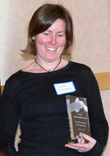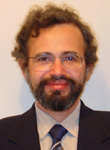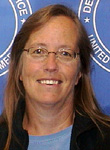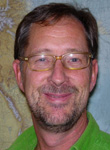|
Performance Awards
Performance Awards Home
Nomination Criteria and Tips
Make a nomination
Contact us via email
Recipients
2014 |
2013 |
2012 |
2011 |
2010 |
2009 |
2008 |
2007 |
2006 |
2005 |
2004 |
1999 - 2003
|
Science and Engineering Awards
 Gary Hodges –ESRL/GMD Gary Hodges –ESRL/GMD
Gary was nominated for his willingness to work beyond his current job description to contribute time and effort to NOAA’s SURFRAD surface radiation budget network. His previous responsibilities managing that network involved responsibility for solar trackers, radiometers, design, installation, operation, data collection, quality control and data distribution. He was then reassigned three years ago to be the official MFRSR (Multi-Filter Rotating Shadowband Radiometers) mentor for the Department of Energy’s Atmospheric Measurement Program (ARM). His new duties include keeping more than 50 MFRSRs operational, participating in two ARM working groups, all considered a full-time job. However, he still continues his important contributions to the SURFRAD program. With extra time created through efficiency (automating many DOE duties including Baseline Surface Radiation Network (BSRN) data submission), Gary continued to bear responsibility for SURFRAD's solar trackers, MFRSR’s, TSI’s, and submission of data to the BSRN archive. Last summer, through his own initiative he designed a better mount for the solar tracker shade mechanism, reducing the potential for error in two key measurements, supervised the project through its manufacturing and installation phases. His nearly continuous MFRSR data record for SURFRAD was recently used to derive the longest running aerosol optical depth climatology for the U.S. (10 yrs), subject of a Journal of Geophysical Research article currently under review, for which Gary is the second author. One huge contribution is that he saved the SURFRAD program over $100,000 by identifying several complete MFRSR systems on an Internet auction, arranging for their purchase and delivery. Last year, Gary further assisted his workplace in that while on personal trips, he consented to decommission a station in Florida and repair a solar tracker in Salt Lake City. DOE also recognized Gary’s efforts in a commendation letter stating that “Gary is one our best Instrument Mentors and provides an outstanding technical contribution to all aspects of his role with ACRF.” (ARM Climate Research Facility).
Augustine, J.A., G.B. Hodges, E.G. Dutton, J.J. Michalsky, and C.R. Cornwall (2008), An aerosol optical depth climatology for NOAA's national surface radiation budget network--SURFRAD,/ //J. Geophys. Res/., accepted
 Allison McComiskey – ESRL/GMD/CSD Allison McComiskey – ESRL/GMD/CSD
McComiskey was hired part-time, to assist with the Department of Energy’s (DOE) Atmospheric Radiation Measurements project. In a short time, her role evolved to leading the team’s observational effort in the field of aerosol-cloud interactions and their impacts on climate change. The impacts of such interactions are listed as the single largest unknown in climate change by the Intergovernmental Panel on Climate Change (IPCC, 2007). She collated and integrated data sets from 12 instruments based on a six-month deployment of the DOE/ARM mobile facility. She performed a variety of innovative analysis methods to reveal new results, and published these new techniques to further the progress in this crucial area. Her innovative analysis methods reveal exciting new results enabling them to quantify the effect of aerosol on cloud drop size and albedo, and the implications for climate change; her radiative transfer modeling explores the extent to which current biases in measurements of aerosol effects on cloud albedo have biased GCM model predictions of this effect. These techniques lead the way for similar studies at other locations, furthering progress towards better understanding the impact of aerosol-cloud interaction mentioned in the IPCC. In addition to the contributions to research in the workplace, she is an active member of the CIRES Members’ Council, also pursuing some studies at CIRES Center for Science and Technology Policy Research.
- McComiskey, A., and G. Feingold, 2008: Quantifying error in the radiative forcing of the first aerosol indirect effect. Geophys. Res. Lett., 35, L02810, doi:10.1029/2007GL032667.
- McComiskey, A., G. Feingold, A. S. Frisch, D. Turner, M. Miller, and Q. Min: Aerosol-cloud interactions at Point Reyes, California. To be submitted, February 2008.
 Oleg Godin – ESRL/PSD Oleg Godin – ESRL/PSD
Oleg Godin is a CIRES Senior Research Scientist with ASAP (Advanced Sensor Application Program) Group at ESRL/PSD (Physical Science Division) and is a renowned authority on the theory of wave propagation in inhomogeneous and moving media. In recent years, he achieved a number of particularly remarkable scientific accomplishments, which demonstrate his initiative, resourcefulness and creativity. He has changed the course of research on two topical subjects both within and beyond CIRES and NOAA. He developed a theory of the so called “tsunami shadows,” i.e., changes in ocean surface roughness induced by tsunami waves, and proposed to use this phenomenon for tsunami detection from space. In 2006-2007, the theory has been confirmed by analyses of satellite imagery. Several groups in the United States, Europe, and Australia are working on satellite-borne early detection and warning systems, which would use the “Godin effect” to assess the threat and save lives when the next catastrophic tsunami strikes. He also discovered the phenomenon of anomalous transparency of water-air interface. Instead of being an almost perfect mirror, as previously believed, water-air interface proves to be a good conduit of low-frequency underwater sound into the atmosphere. The phenomenon completely changes the outlook on the possibility of acoustic communication through the water-air interface and has important geophysical, biological, and national security implications. Anomalous transparency of water-air interface suggests that, contrary to common wisdom, infrasonic observations in air are better suited for acoustic detection of powerful underwater explosions than observations with underwater receivers. Beyond his regular job responsibilities, Godin compiled and edited 1200-page multi-author book History of Russian Underwater Acoustics (World Scientific, 2008). This book brings to the Western reader a wealth of information, which remained classified or otherwise unavailable until recently, and will promote international cooperation in this important scientific and engineering discipline. Also beyond his regular job responsibilities, in order to commemorate his late mentor and outstanding Russian scientist Acad. Prof. L. M. Brekhovskikh, Godin prepared for publication in Russian a fundamental, 1000-page treatise of sound propagation (L. M. Brekhovskikh and O. A. Godin, Acoustics of Inhomogeneous Media. Vol. 1, Fundamentals of Sound Reflection and Propagation Theory, Nauka, Moscow, 2007; Vol. 2, Sound Fields in Layered and 3-D Inhomogeneous Environments, Nauka, Moscow, in press). This book is an extended and updated version of Acoustics of Layered Media by the same authors published in English by Springer-Verlag in 1990-1999. As one indication of the significance of the new book, it is being published in the extremely selective series called Monuments of National Science, which is sponsored by the Russian Academy of Sciences. Judging from the international recognition Acoustics of Layered Media has received, the new book will be a seminal contribution to environmental acoustics.
Service Awards
 Christine Ennis – ESRL/CSD Christine Ennis – ESRL/CSD
Ennis is nominated for her voluntary role as the Coordinating and Technical Editor of the Scientific Assessment of Ozone Depletion 2006 produced under the World Meteorological Organization/United Nations Environment Program (WMO/UNEP), and published in 2007. This report was comprised of 3 parts: 1) the Scientific Assessment of Ozone Depletion 2006 (main report body, 411 pgs in length); 2) the teaching component titled, "Twenty Questions and Answers About the Ozone Layer"; and 3) The Executive Summary. With her exceptional leadership as the coordinating editor of this assessment, Ennis has brought distinction to CIRES as an institution that serves the international science and policy community. The sheer magnitude of this task required initiative, resourcefulness and creativity to ensure that a brutal timeline was met, consistency and correctness of details was achieved, which included personal oversight of the 166 figures included in the report as well as recommendations of changes for improved presentation clarity or completeness to many authors. The assessment document was produced in service to the 192 nations that are parties to the Montreal Protocol. Scientists and policymakers rely upon the UNEP/WMO assessments to make decisions about future scientific research and regulatory actions. The U.S. Clean Air Act is also guided by the reports. The Twenty Questions component educates students, teachers, and the public in a simple, easy-to-follow format and has been distributed worldwide. Ennis chose to volunteer for this role as Coordinating and Technical Editor, the WMO/UNEP has no internal resources to accomplish such a task. This accomplishment was well beyond Ennis' required duties in support of the ESRL/CSD Directorate. The remarkable technical, editorial quality of the final document brings credit the cooperative NOAA/CIRES workplace.
 Mark McCaffrey – Outreach Mark McCaffrey – Outreach
Mark McCaffrey was nominated in recognition of his sustained and impassioned personal commitment to science education in support of CIRES, the University of Colorado and his community. Mark demonstrated initiative and resourcefulness by organizing and participating in the kickoff celebration of "Ice Fest". He saved money by "cajoling" many colleagues to volunteer ideas, time and materials in order to launch the International Polar Year (IPY) festivities. This was a two day community event which drew media attention, public attendance, and saw several hundred visiting students who participated while on campus for recruitment activities. In addition to the IPY kickoff, examples of Mark’s substantial contribution within and without the workplace include: 1) again, as part of the IPY, Mark invested personal time participating as a member of the Joint Subcommittee on Education as the United States representative, providing congressional testimony on IPY education; 2) solely on his own, Mark became one of the Climate Project presenters trained and authorized to give the "An Inconvenient Truth" slide show. He presented this several times at the Focus the Nation events on 1/31/08, and at the CU Environmental Center, as well as many other events. He is not paid for this, nor is it part of his normal Outreach duties. Although it's always hard to determine how a person rostered in Outreach goes above their regular duties, in Mark's case he is definitely engaged in service for which he is not paid, activities undertaken on his own time which do benefit us and CU. In addition to the previously mentioned items, he also developed a new slide show tied to the newly developed NOAA Climate Literacy Framework, which will be used to train EPA climate communicators in basic climate science. He was not paid to do this. He also is a member of the City of Lafayette Energy Advisory Committee. This committee is charged with the development of a proposed community energy center in Lafayette. He has tried to promote CU connections with the community through all of this work, especially in relation to the Flagship 2030 plan.
|